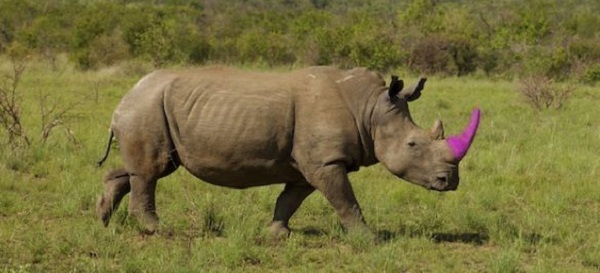
As the fight to save to rhino continues, scientist, wildlife workers, and activists worldwide are searching for methods of deterring poachers. Wildlife workers at Sabi Sand, a private game reserve at the southernmost tip of Kruger National Park, have devised an unusual and rather bright method to help save the species. The reserve has injected a specially designed, poisonous pink dye into 100 of its rhino.
The pink dye provides many forms of deterrents, the first being its obvious bright and unnatural colouring. The second is that the dye has been mixed with parasiticidees, usually used to control ticks. Although the poison is not intended to kill either the poachers or the consumers who ingest it, it does cause side effects such as, nausea, vomiting and diarrhea. Ironically, these are a few of the aliments the rhino horn is falsely believed to cure. Rhino horns are made up of the same fibrous protein which is also found in human nails and hair. The third and final deterrent is that the pink dye can be detected by airport scanners, even when the horn itself is in the form of powder.
Already this year over 200 rhinos in South Africa, have died from poaching. On the black market, the demand for rhino horn for both medicinal and decorative purposes is steadily growing. Tradition medicines have become increasing popular, says Tom Milliken, Rhino Program coordinator with Traffic, a leading wildlife trade-monitoring network. He says, “There is a whole new market that advertises rhino horn as a successful cancer treatment. It’s being marketed in hospitals to the families of the critically ill. In addition, it has also become a trendy hangover remedy”.
Although the method offers promise, some experts and activist have voiced concerns regarding the ethical implications of intentionally poisoning something that may be ingested. Dr. Susie Ellis, Executive Director of the International Rhino Foundation, one of the individuals who has expressed these concerns, has also recognised the benefits the project potentially offers, “If this strategy discourages even one person from buying horn, I think it’s marvellous”.
Tom Milliken, also understands the value of every individual rhino that can be saved, yet isn’t fully supportive of the project. “I’m not sure I fully buy the notion that this dye cocktail has been adequately tested and certified to be non-harmful to rhinos,” he says. “The process of anesthetizing living rhinos to inject the cocktail is time consuming and entails risks; we know of rhinos in the private sector that have died in the process, including one at an event to specifically showcase this particular dye technique“.
Although the technique offers promise in deterring those seeking the traditional medicine, the market for rhino horn is changing. Products made from rhino horn have become popular gifts within some areas. Unfortunately, a simple bleaching process can transform the pink horn back into a product that can cater to the market.
“Vietnam has recently emerged as the single largest market for rhino horn,” says Dr. Ellis. “In Vietnam, it is now given as a high value gift item. Give a horn instead of a Rolex—it’s worth its weight in gold“.
In addition to dying the horns pink, Sabi Sand have advertised their poisoned horns with signs around the reserve. Whether or not the project is successful, due to the resources required to catch and treat the rhinos every three to four years, the technique is unlikely to be widely replicated.
However, along with dehorning, unmanned security drones and even 3D printing of genetically identical rhino horns, the technique could contribute to saving this incredible species.
You want to support Anonymous Independent & Investigative News? Please, follow us on Twitter: Follow @AnonymousNewsHQ





http://www.snopes.com/photos/animals/pinkhorns.asp
Please don’t tell me you trust Snopes!This is owned by Soro’s and I wouldn’t trust this with my life…
http://www.snopes.com/photos/animals/pinkhorns.asp
Hopefully that will work on the consumer end.
“Although the method offers promise, some experts and activist have voiced concerns regarding the ethical implications of intentionally poisoning something that may be ingested.” Why? There are substantially less rhinos left in the world compared to the 6 billion+ humans left, I really hope this kills some humans so that more rhinos may live.
Dying the horns pink have caused the rhinos with dyed horns to be unable to find mates and reproduce, so essentially this will kill them more effectively